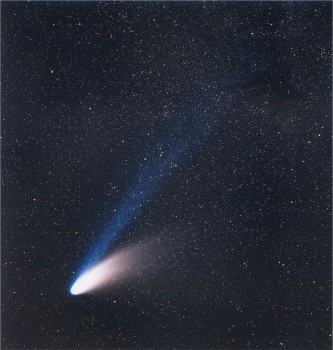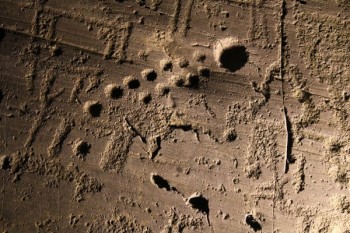After Rosetta (clearly, especially if you’re following this blog!) what’s the first name that comes to our minds when talking about comets? I bet for many of us it’s going to be Halley’s Comet, possibly the most renowned among all ‘long-haired stars’ that ever crossed our skies.

Comet Hale-Bopp (C/1995 O1) photographed on 14 March 1997. Credit: ESO/E. Slawik.
A regular visitor every seventy-six years or so, Halley’s Comet has done way more than just enchant and fascinate: in the past four centuries, each and every one of this comet’s appearances have triggered major leaps for the advancement of astronomy, physics and general science. On the occasion of its latest trip through the inner Solar System, in 1986, the progress of space technology allowed scientists worldwide to send a fleet of spacecraft to fly by the comet and study it up close. I wonder what will happen next time, in 2062.
While many of you probably remember Halley’s Comet’s 1986 visit, I don’t really recall it. Sure, I was already toddling somewhere on our planet’s surface at the time, but maybe a teeny bit too young to have first-hand memories of this celestial wanderer. What I remember – and quite vividly, too – is Comet Hale-Bopp, shining brightly, slightly above my hometown’s medieval castle for days and days in the Spring of 1997.
I guess that’s the story with comets, even for the lucky ones among us who have gazed way more than one: we all have our favourite, and I’m sure it’ll be pretty hard to dethrone the striking image of Hale-Bopp from my memory. Maybe a Great Comet will do the job one day – but it’s got to be a really great one.
Since no spectacular comet is on our way any time soon, I decided to turn the other way around, looking back on our history and hunting down the ghosts of comets past. Little did I know, before embarking on this journey through the centuries – nee, through the millennia! – that comets and humankind share such a rich and fascinating history that blew me away almost as much as would the sight of a Great Comet bridging across half of the sky.

The “comet” symbol found on Rock 35 from Area di Foppe, Nadro di Ceto (Brescia, Italy). Riserva naturale Incisioni rupestri di Ceto, Cimbergo e Paspardo. Copyright: Centro Camuno di Studi Preistorici, Dipartimento Valcamonica e Lombardia
The origins of our fascination with comets go back to time immemorial, surely beyond the reach of any archeological record. Interestingly, there are claims that a symbol found among the rock carvings in Val Camonica, close to Lake Garda in the North of Italy, may in fact be a comet. And not just any comet: while its dating is uncertain, it can be pushed back to the seventh century BCE, and some did even speculate that it may represent none other than Halley’s Comet!
More reliable records of comets – dozens and dozens of them – appear in ancient chronicles from Chinese, Greek, Roman and Babylonian astronomers, and the variety of interpretations that philosophers and scientists put forward in ancient times shows how hot the topic was already back then. However, while a few ancient scholars did have some good intuition, these remained long unpopular and it wasn’t until the modern era that astronomers began to figure out what comets really are.
It took a Great Comet, the one of 1577, and a great astronomer, Tycho Brahe, to convince the world that comets are celestial objects. This revelation was also one of the first nails in the coffin of the geocentric system, which was already not in great shape at the time, after Copernicus had published his new heliocentric system in 1543. So comets did contribute a great deal to the revolutionary shift in world-view that threw us humans away from the centre of the Universe.
Soon after, they would do even more, providing an extra case study for scientists to test Newton’s theory of universal gravitation. Having understood how gravity works, it became possible to compute the orbits of comets and, thanks to the work and intuition of Edmond Halley, even to predict their return. At the turn of the eighteenth century, Halley was the first to notice that at least some comets are periodic, bound to come back regularly: these mysterious objects that seemed to violate the order of the heavens were eventually ushered in the reassuring realm of the predictable.
The following couple of centuries saw a boost in the study, observation and understanding of comets. Finally, a clear picture came together in the 1950s, with Fred Whipple describing comets as ‘dirty snowballs’ and Jan Oort conjecturing that most of them live in a huge, spherical cloud that is gravitationally bound to the Solar System and encloses it from far, far away. These discoveries revealed how far-reaching the study of comets and their physical nature is, as these icy bodies lock up many clues about the origin of the Sun and planets some 4.5 billion years ago.
With the dawn of the space age, planetary scientists started to explore our cosmic neck of the woods, and it didn’t take long until a few comets were visited by spacecraft that flew by them, observing their surfaces and sampling particles in their surroundings. But many secrets are still to be unlocked, and Rosetta is about to fill in many pages in the exciting history of comets.
Quite a short summary for such a rich history! But if you enjoyed this sneak peek and would like to read more about the everlasting fascination of humankind with comets, take a look at this series of articles that were just published today on ESA’s Science & Technology website:
- A History of Comets – Part 1: From harbingers of doom to celestial wanderers
- A History of Comets – Part 2: Testing gravity: How comets helped to prove Newton right
- A History of Comets – Part 3: On the origin of comets
- A History of Comets – Part 4: Triumphs of the space age: Rendezvous with a comet
Acknowledgement: during this journey chasing comets across history, I received valuable input from Dr. Robert H. van Gent, a historian of astronomy at Utrecht University, who helped me navigate through the rich history of comets and humankind, pointing me to several publications, plenty of images and information.









Discussion: one comment
Thank you Claudia and Rosetta Blog editors for setting the stage with this historical overview, giving us perspective on human development as it looks to the skies. We all wish you continued success in your technical achievements and hope that you will able to apply the new knowledge to better sustain the fragile and endangered life still found on this planet.